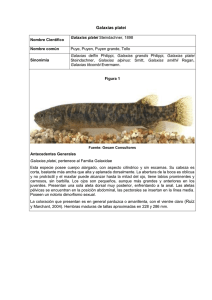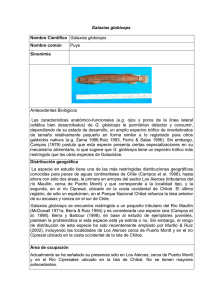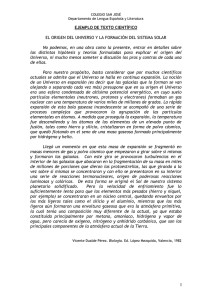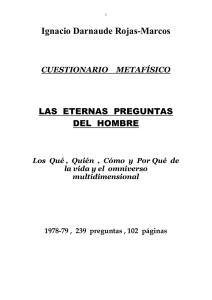Cephalic sensorial pores in galaxiid fishes from Chile
Anuncio
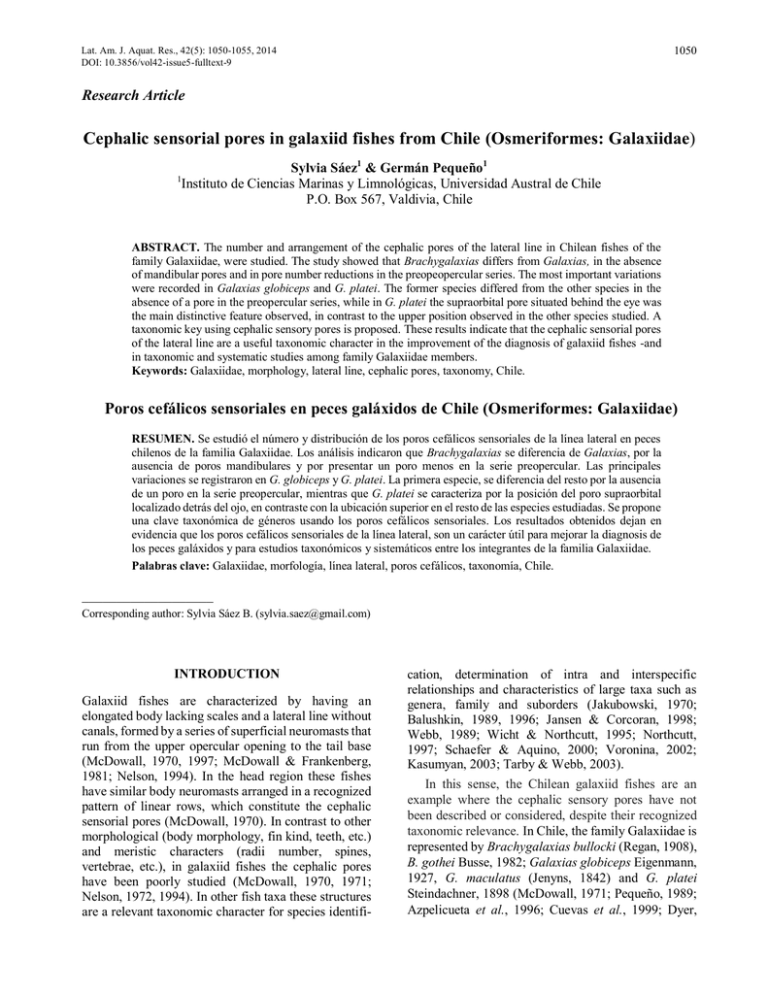
Lat. Am. J. Aquat. Res., 42(5): 1050-1055, 2014 DOI: 10.3856/vol42-issue5-fulltext-9 Cephalic sensorial pores in galaxiid fishes 10501 Research Article Cephalic sensorial pores in galaxiid fishes from Chile (Osmeriformes: Galaxiidae) Sylvia Sáez1 & Germán Pequeño1 Instituto de Ciencias Marinas y Limnológicas, Universidad Austral de Chile P.O. Box 567, Valdivia, Chile 1 ABSTRACT. The number and arrangement of the cephalic pores of the lateral line in Chilean fishes of the family Galaxiidae, were studied. The study showed that Brachygalaxias differs from Galaxias, in the absence of mandibular pores and in pore number reductions in the preopeopercular series. The most important variations were recorded in Galaxias globiceps and G. platei. The former species differed from the other species in the absence of a pore in the preopercular series, while in G. platei the supraorbital pore situated behind the eye was the main distinctive feature observed, in contrast to the upper position observed in the other species studied. A taxonomic key using cephalic sensory pores is proposed. These results indicate that the cephalic sensorial pores of the lateral line are a useful taxonomic character in the improvement of the diagnosis of galaxiid fishes -and in taxonomic and systematic studies among family Galaxiidae members. Keywords: Galaxiidae, morphology, lateral line, cephalic pores, taxonomy, Chile. Poros cefálicos sensoriales en peces galáxidos de Chile (Osmeriformes: Galaxiidae) RESUMEN. Se estudió el número y distribución de los poros cefálicos sensoriales de la línea lateral en peces chilenos de la familia Galaxiidae. Los análisis indicaron que Brachygalaxias se diferencia de Galaxias, por la ausencia de poros mandibulares y por presentar un poro menos en la serie preopercular. Las principales variaciones se registraron en G. globiceps y G. platei. La primera especie, se diferencia del resto por la ausencia de un poro en la serie preopercular, mientras que G. platei se caracteriza por la posición del poro supraorbital localizado detrás del ojo, en contraste con la ubicación superior en el resto de las especies estudiadas. Se propone una clave taxonómica de géneros usando los poros cefálicos sensoriales. Los resultados obtenidos dejan en evidencia que los poros cefálicos sensoriales de la línea lateral, son un carácter útil para mejorar la diagnosis de los peces galáxidos y para estudios taxonómicos y sistemáticos entre los integrantes de la familia Galaxiidae. Palabras clave: Galaxiidae, morfología, línea lateral, poros cefálicos, taxonomía, Chile. ___________________ Corresponding author: Sylvia Sáez B. ([email protected]) INTRODUCTION Galaxiid fishes are characterized by having an elongated body lacking scales and a lateral line without canals, formed by a series of superficial neuromasts that run from the upper opercular opening to the tail base (McDowall, 1970, 1997; McDowall & Frankenberg, 1981; Nelson, 1994). In the head region these fishes have similar body neuromasts arranged in a recognized pattern of linear rows, which constitute the cephalic sensorial pores (McDowall, 1970). In contrast to other morphological (body morphology, fin kind, teeth, etc.) and meristic characters (radii number, spines, vertebrae, etc.), in galaxiid fishes the cephalic pores have been poorly studied (McDowall, 1970, 1971; Nelson, 1972, 1994). In other fish taxa these structures are a relevant taxonomic character for species identifi- cation, determination of intra and interspecific relationships and characteristics of large taxa such as genera, family and suborders (Jakubowski, 1970; Balushkin, 1989, 1996; Jansen & Corcoran, 1998; Webb, 1989; Wicht & Northcutt, 1995; Northcutt, 1997; Schaefer & Aquino, 2000; Voronina, 2002; Kasumyan, 2003; Tarby & Webb, 2003). In this sense, the Chilean galaxiid fishes are an example where the cephalic sensory pores have not been described or considered, despite their recognized taxonomic relevance. In Chile, the family Galaxiidae is represented by Brachygalaxias bullocki (Regan, 1908), B. gothei Busse, 1982; Galaxias globiceps Eigenmann, 1927, G. maculatus (Jenyns, 1842) and G. platei Steindachner, 1898 (McDowall, 1971; Pequeño, 1989; Azpelicueta et al., 1996; Cuevas et al., 1999; Dyer, 1051 2 Latin American Journal of Aquatic Research 2000; Jara-Seguel et al., 2008a, 2008b; Habit & Victoriano, 2012; Habit et al., 2012). In this study we describe the morphology (pore distribution and arrangement) and meristics (pore count) of the sensorial cephalic pores in Chilean Galaxiidae. Comparative analyses of these sensorial structures among galaxiid fishes were also carried out. The results obtained in this study may offer a starting point to know more about these structures and their potential usefulness in taxonomic and systematic studies, and considered also as tools for comparative analyses among other Osmeriformes in the future. MATERIALS AND METHODS Material examined Institutional abbreviation: IZUA PM Instituto de Zoología, Universidad Austral de Chile, MNHNC Museo Nacional de Historia Natural de Chile. The samples examined in this study were: - Brachygalaxias bullocki: six specimens, MNHNC (uncatalogued) Cruces River (Valdivia), 11/01/2006. - Brachygalaxias gothei: 35 specimens MNHNC (uncatalogued), Cruces River, 12/01/2006. - Galaxias maculatus: two specimens, IZUA PM 463, Quellón Viejo, 25/4/1975, 24 specimens, IZUA PAD 1887, Riñihue Lake 14/1/1976, 18 specimens IZUA PM 628, Lingue River, 16/3/1977, four specimens, IZUA PAD 3992, Chamiza Bajo River, 22/9/1980. - Galaxias globiceps: three juvenile specimens MNHNC P. 6860, Avellano River (Puerto Montt), 27/11/1992. - Galaxias platei: one specimen, IZUA PAD 3295, one specimen IZUA PAD 2832, Tepu River 22/9/1982, three specimens IZUA PAD 2627, one specimen IZUA PAD 3449, Tepu River 22/2/1983, 10 specimens IZUA PAD 4394 Pescado River, 19/3/1991. Methodology Measurements (expressed in mm): total length (TL), standard length (SL) and head length (HL) were made on each specimen. The number, morphology and arrangement of sensorial pores were observed in the cephalo-caudal direction following the methods of McDowall (1970). Cephalic pore abbreviations are: SOP supraorbital pores, infraorbital pores, iOP interorbital pores. MP mandibular pores, PPP preopercular pores, INOP interorbital pores (Figs. 1-3). RESULTS Morphometric traits The morphometric ranges observed were: Brachygalaxias bullocki TL = 19-35 mm, SL = 7-29 mm, HL = 4-8 mm; B. gothei TL = 24-36 mm, SL = 21-27 mm, HL = 4-7 mm; G. maculatus TL = 48-122 mm, SL = 42-107 mm, HL = 9-24 mm; G. globiceps TL = 23-26 mm, SL = 21-24 mm, HL = 5-6 mm; G. platei TL = 48-215 mm, SL = 41-185 mm HL = 16-39 mm. Morphological study In Brachygalaxias and Galaxias species, five cephalic regions with sensorial pores were observed: a) Supraorbital series: this series originates from the anterior margin of the nasal bone (Figs. 1, 3). b) Infraorbital series: anterior branch that arises from the dorsolateral continuation of the supraorbital series, directed posteriorly bordering the eye and curving centrally (Figs. 1-2). c) Interorbital series: situated above the supraorbital pores (Figs. 1, 3). d) Preopercular series: this series is originated from the preopercular bone. The same series is deflected and joined at the mandibular series; it gives rise to the preoperculo-mandibular series (Figs. 1-2). e) Mandibular series (absent in Brachygalaxias specimens): this series is situated at the mandibular bone (Fig. 2). Particular morphology descriptions of each taxon follows: - Genus Brachygalaxias Cuvier, 1816 In both species of this genus, B. bullocki and B. gothei, a pattern without variations in its form, extension and arrangement, was observed in all cephalic pores (Figs. 1a-1b). - Genus Galaxias Eigenmann, 1928 A difference was found in the supraorbital pore series in G. platei specimens in which the supraorbital series begins behind the eye (Fig. 3a), while in the rest of species the supraorbital series is situated above the orbit (Fig. 3b). Cephalic pores meristics - Genus Brachygalaxias Cuvier, 1816. In Brachygalaxias bullocki and B. gothei there is one pore less than in the other specimens of the genus Galaxias here studied (Table 1). The numbers of pores in B. bullocki and B. gothei, were: five preopercular, three infraorbital, two supraorbital and three interorbital 10523 Cephalic sensorial pores in galaxiid fishes Figure 1. General scheme of number and arrangement of sensorial cephalic pores observed in Brachygalaxias bullocki and B. gothei: a) Lateral view, b) dorsal view (Modified from McDowall, 1971 and Nelson, 1972). IOP: Infraorbital pores series, PPP: Preopercular series pores, SOP: supraorbital pores. MP IOP a PPP PPP b c Figure 2. Lateral view of the arrangement and number of pores observed in specimens of the genus Galaxias of Chile: a) Infraorbital pores series (IOP) and mandibular pores (MP) of G. globiceps, G. maculatus and G. platei, b) preopercular series pores (PPP) of G. maculatus and G. platei, c) preopercular series observed in G. globiceps and in some specimens of the sample of G. maculatus (N = 4) and G. platei (N = 2) (Modified from McDowall, 1971). (Figs. 1a-1b). The absence of mandibular pores was the principal feature in this taxon. - Genus Galaxias Eigenmann, 1928 In all G. globiceps, G. maculatus and G. platei specimens studied showed six preopercular, two mandibular, three infraorbital, two supraorbital and three interorbital pores (Figs. 2a, 2b, 3b). However, one pore less in the preopercular series was observed in three specimens of G. globiceps, four specimens of G. maculatus and two specimens of G. platei (Fig. 2c, Table 1). Taxonomic key based on cephalic sensory pores of the Chilean Galaxiid fish genera 1a. MP absent. Five PPP. Last pore (in cephalic direction) of the INOP arranged in parallel row with respect to the SOP….…Genus Brachygalaxias (Fig. 1). 1b. MP present. Six (sometimes five) PPP. Last pore (in cephalic direction) of the INOP arranged diagonally with respect to the SOP……...Genus Galaxias (Fig. 3). DISCUSSION The morphological and meristic study of cephalic sensorial pores of Chilean galaxiid fishes showed that the main differences are located in the preopercular and mandibular pore series. The observations indicated that Brachygalaxias differed from Galaxias because of the absence of mandibular pores and pore number reductions in the preopercular series. Such morphological and meristic traits represented the main difference among Brachygalaxias specimens, as described by McDowall (1971). This author confirmed that the absence or disappearance of mandibular pores 1053 4 Latin American Journal of Aquatic Research iOP SOP SOP iOP a Dorsal View Lateral view b Figure 3. Arrangement of the sensorial pores of the supraorbital (SOP) and interorbital (INOP) series in: a) G. platei. b) G. maculatus and G. globiceps. The arrows indicate the different pores position, in the arragement within the system (Modified from McDowall, 1970). Table 1. Number of preopercular sensorial pores in fishes of the family Galaxiidae of Chile. Species Brachygalaxias bullocki Brachygalaxias gothei Galaxias globiceps Galaxias maculatus Galaxias platei Total number of specimens 6 35 3 48 16 is common in several galaxiid species (R.M. McDowall, pers. comm.). In the preopercular series, the Brachygalaxias specimens present one pore less than the Galaxias specimens, reflecting a second relevant difference among the specimens of the genera. It should be pointed out that our results for B. bullocki differ from previously published data (McDowall, 1971). This difference was observed in the infraorbital pore series, where all the specimens analyzed showed an absence of one pore, but not four pores as described by Nelson (1972). In B. gothei no data for comparison with our results are available. The morphological and meristic characteristics of cephalic sensorial pores in B. gothei are described and illustrated for the first time in this study. With reference to the genus Galaxias, the count and arrangement of the cephalic pores were similar to those described in the literature (McDowall, 1970, 1971; McDowall & Frankenberg, 1981). However, in some Number of preopercular pores series 5 6 6 0 35 0 3 0 4 44 2 14 specimens of G. maculatus, G. platei and in the complete sample of G. globiceps, the absence of one pore in the preopercular series was recorded. We believe that in the case of G. platei, this meristic variation could be explained only through intraspecific variation (Milano et al., 2006), however, it is necessary to have more specimens from different localities to corroborate this suggestion. In the particular case of G. globiceps, further samples of this taxon are required for more accurate interpretation of this assumption. It should be also noted that G. globiceps is considered as a scarce, vulnerable and rare species (Murillo & Ruiz, 2002; Habit et al., 2006; SUBPESCA, 2011). The latter is a difficult issue to manage, and for the present it is an obstacle to obtaining more specimens. Another important aspect to be considered refers to the complete sample of G. platei. The arrangement of the preopercular pore series was localized behind the eye. This observation constitutes a distinctive specific Cephalic sensorial pores in galaxiid fishes characteristic compared to the upper disposition shown in the other members of this genus. The cephalic sensory pores of the specimens studied are relevant because they allow distinguishing between the genera Brachygalaxias and Galaxias, as shown by the taxonomic key here generated. However, the scarce information on cephalic sensorial pores of body lateral line, transforms an exhaustive comparison in a difficult issue to be achieved, as compared to that described in the present study. Therefore, this study is aimed initiate the morphological and meristic comparative descriptions of these sensorial structures, which can later be used as a distinctive feature in the improvement of the diagnosis of galaxiid fishes and in future taxonomic and systematic studies of Galaxiidae taxa. ACKNOWLEDGMENTS The authors are grateful to the Dirección de Investigación y Desarrollo (DID) of Universidad Austral de Chile for supporting our projects, to Gloria Arratia (Lawrence, Kansas, USA), the late Robert M. McDowall (Christchurch, New Zealand) and Richard L. Haedrich (Newfounland, Canada), for their valuable ichthyologic literature contribution. Klauss Busse (Bonn, Germany) kindly helped with valuable comments. This are partial results of the Project FIP-2013-29 enrolled in Dirección de Investigación y Desarrollo de la Universidad Austral de Chile. REFERENCES Azpelicueta, M., A. Almirón, A. López-Cazorla & J. Casciotta. 1996. Geographical distribution of Galaxias maculatus (Jenyns) (Pisces: Osmeriformes: Galaxiidae) in Patagonia. Biogeographica, 72(4): 157-160. Balushkin, A.V. 1989. Morphological bases of the systematics and phylogeny of the Nototheniid fishes. Zoological Institute, Academy of Sciences U.S.S.R., Leningrad, 153 pp. Balushkin, A.V. 1996. Structure and evolution of the trunk lateral lines of the Nototheniodei (Perciformes). J. Ichthyol., 36(6): 419-429. Cuevas, C.C., H. Campos & K. Busse. 1999. Studies on Chilean galaxiid fishes. The karyotypes, C- bands, AgNORs and hybrids of Brachygalaxais gothei and B. bullocki (Osteichthyes: Galaxiidae). Cytologia, 64: 379-385. Dyer, B.S. 2000. Systematic review and biogeography of the freshwater fishes of Chile. Estud. Oceanol., 19: 7798. Habit, E. & P. Victoriano. 2012. Composición, origen y valor de conservación de la ictiofauna del Río San 10545 Pedro (Cuenca del Río Valdivia, Chile). Gayana, 76(Supl. 1): 10-23. Habit, E., B. Dyer & I. Vila. 2006. Estado de conocimiento de los peces dulceacuícolas de Chile. Gayana, 70(1): 100-113. Habit, E., J. González, D.E. Ruzzante & S.J. Walde. 2012. Native and introduced fish species richness in Chilean Patagonian lakes: inferences on invasion mechanisms using salmonid-free lakes. Divers. Distrib., 18: 1-13. Jakubowski, M. 1970. Morphological features of the lateral line organs in members of the Antarctic genus Trematomus Boul. (Nototheniidae, Pisces). J. Ichthyol., 10(2): 268-271. Jansen, J. & J. Corcoran. 1998. Determination via the lateral line in the mottled sculpin. Copeia, 1998(3): 657-662. Jara-Seguel, P., I. Valdebenito & C. Palma-Rojas. 2008a. Contenido de ADN nuclear en Galaxias platei (Steindachner, 1898) (Teleostei: Osemeriformes: Galaxiidae). Gayana, 72(2): 196-201. Jara-Seguel, P., I. Valdebenito, C. Palma-Rojas & C. Rebolledo. 2008b. Nuclear DNA content in Galaxias maculatus (Teleostei: Osemeriformes: Galaxiidae). Lat. Am. J. Aquat. Res., 36(1): 87-91. Kasumyan, A.O. 2003. The lateral line in fish: structure, function, and role in behavior. J. Ichthyol., 43 (Suppl. 2): S175-S213. McDowall, R.M. 1970. The galaxiid fishes of New Zealand. Bull. Mus. Comp. Zool., Harv. Univ., 139(7): 341-431. McDowall, R.M. 1971. The galaxiid fishes of South America. Zool. J. Linn. Soc., 50: 33-73. McDowall, R.M. 1997. An accessory lateral line in some New Zealand and Australian galaxiids (Teleostei: Galaxiidae). Ecol. Fresh. Fish, 6: 217-224. McDowall, R.M. & R.S. Frankenberg. 1981. The galaxiid fishes of Australia. Rec. Aust. Mus., 33(10): 443-605. Milano, D., D.E. Ruzzante, V.E. Cussac, P.J. Macchi, R.A. Ferriz, J.P. Barriga, J.C. Aigo, M.E. Lattuca & S.J. Walde. 2006. Latitudinal and ecological correlates of morphological variation in Galaxias platei (Pisces, Galaxiidae) in Patagonia. Biol. J. Linn. Soc., 87: 6982. Murillo, V. & V.H. Ruiz. 2002. El puye Galaxias globiceps Eigenmann 1927 (Osteichthyes: Galaxiidae): ¿Una especie en peligro de extinción? Gayana, 66(2): 191-197. Nelson, G.J. 1972. Cepahlic sensory canals, pitlines, and the classification of esocoid fishes, with notes on galaxiids and other teleosts. Am. Mus. Novit., 2492: 149. 1055 6 Latin American Journal of Aquatic Research Nelson, J.S. 1994. Fishes of the world. John Wiley & Sons, New York, 600 pp. Northcutt, R.G. 1997. Evolution of gnathostome lateral line ontogenies. Brain Behav. Evol., 50(1): 25-37. Pequeño, G. 1989. Peces de Chile. Lista sistemática revisada y comentada. Rev. Biol. Mar. Valparaíso, 24(2): 1-132. Schaefer, S.A. & A.E. Aquino. 2000. Postotic laterosensory canal and pterotic branch homology in catfishes. J. Morphol., 246(3): 212-227. Subsecretaría de Pesca (SUBPESCA). 2011. Veda extractiva para fauna íctica nativa amenazada de aguas continentales. Unidad de Biodiversidad y Patrimonio Acuático División de Administración Pesquera, Valparaíso. Inf. Téc. Nº 48/2011: 133 pp. Received: 6 September 2013; Accepted: 15 August 2014 Tarby, M.L. & J.F. Webb. 2003. Development of the supraorbital and mandibular lateral line canals in the cichlid, Archocentrus nigrofasciatus. J. Morphol., 255(1): 44-57. Voronina, E.P. 2002. Morphology of the acousticolateralis system of some Pleuronectids: communication 1. J. Appl. Ichthyol., 42(8): 555-564. Webb, J.F. 1989. Gross morphology and evolution of the mechanoreceptive lateral-line system in teleost fishes. Brain Behav. Evol., 33(1): 34-53. Wicht, H. & R.G. Northcutt. 1995. Ontogeny of the head of the Pacific hagfish (Eptatretus stouti, Myxinoidea): development of the lateral line system. Philos. T. Roy. Soc. B, 349(1328): 119-134.
